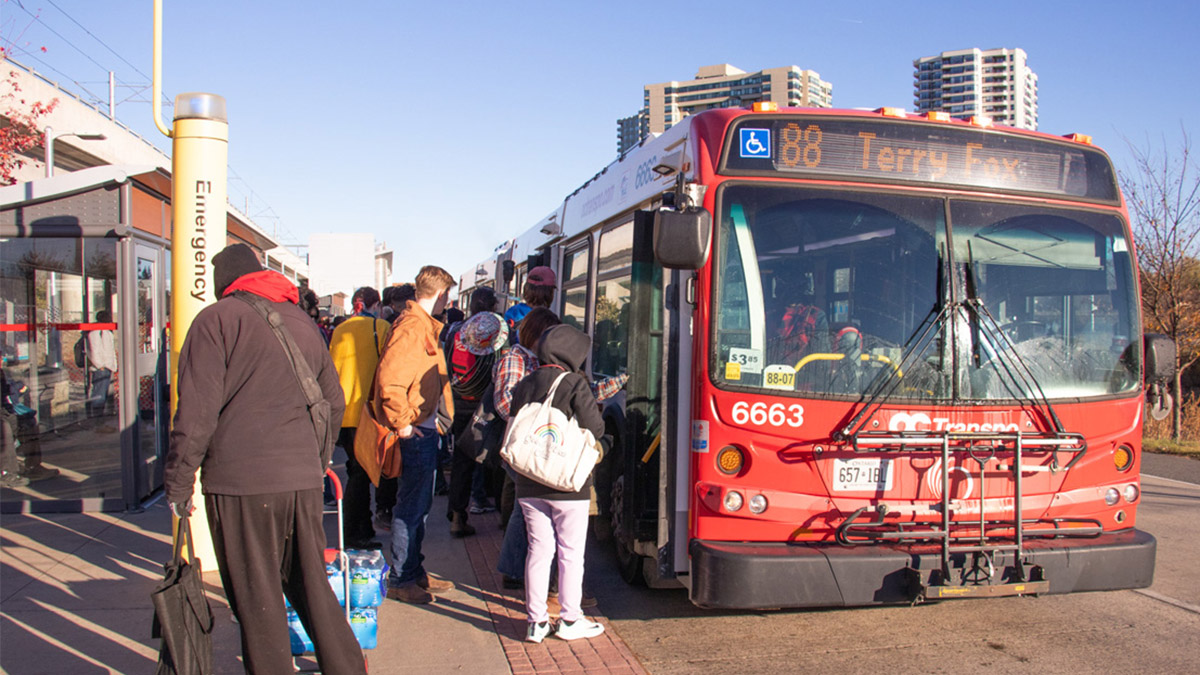Facing widespread public dissatisfaction with the reliability of Ottawa’s transit system, OC Transpo officials gave city councillors an overview of its performance standards at a transit committee meeting on June 12.
The review focused on data from Route 11, which runs from the west-end Bayshore Shopping Centre to Waller Street in the downtown core, a key stop for University of Ottawa students.
The study was done to see if and how OC Transpo can achieve its service reliability objectives, which include minimizing trip cancellations, enhancing transit priority and reducing delays.
OC Transpo uses three different service reliability measures to quantify the success of their bus lines: service delivery, service punctuality, and service regularity.
Service delivery refers to the percentage of planned trips reliably carried out, with OC Transpo aiming for a 99.5 per cent success rate. Service regularity refers to how evenly spaced apart buses are to ensure fairly predictable bus arrivals and wait times.
The “acceptable headway” between buses is defined as being the scheduled time gap between buses, plus a 40-per-cent buffer period. For a service with scheduled 15-minute intervals, OC Transpo sets 21 minutes as the maximum gap between vehicles.

Service punctuality, which refers to the percentage of buses that are on-time as opposed to early or late, is mostly used for less frequented routes.
“Service regularity provides a more nuanced measure of reliability for more frequent routes like Route 11, where achieving consistent headway between trips is the goal,” said Scott Bagg, who head’s OC Transpo’s transit service reliability team.
Route 11 notably struggled with reliability during the winter months earlier this year. During the January-April service period, Route 11 had a 90 per cent service delivery rate, well below the target of 99.5. Additionally, the service regularity rate was only about 75 per cent, significantly off the target rate of 85.
“Within that Winter 2025 service period, there were multiple Level 4 severe storm events that did impact service system-wide between February 13 and 20,” said Bagg.
However, in the spring, service delivery was up to nearly 98 per cent, while service regularity rose to 84 per cent.
The study also looked at the variability of travel times, which is defined as “fluctuations in the time required to complete a run on a transit route for a given direction, time of day, and segment of the route.”
“Travel time variability is impacted by a number of factors,” Bagg said. “This includes traffic volumes and congestion, which we’re continuing to see post-COVID. There’s also planned disruptions like construction and major events, as well as unplanned ones such as adverse weather and protests, which commonly impact Route 11.”
Bagg says that the area between Golden Avenue and Preston Street in both directions has the highest amount of variability on Route 11. He said if more transit priority infrastructure were added to this section of the corridor, performance could be improved.
“As the level of transit priority that exists increases, the less these factors have an impact on the travel time variability,” Bagg continued.
Among suggestions to improve transit priority are measures such as bus lanes, transit priority signals at intersections and “bus bulbs,” which are bus stops that extend onto a roadway.
OC Transpo estimates that transit priority measures that save one minute per trip on frequent service lines can reduce service-hour requirements by 290 hours per year, which could save over $40,000 annually in operating costs.
“While the benefits of an individual change to an on-street condition may seem at times trivial, these changes add up,” Bagg said. “Customers benefit from faster average travel times and more consistent and predictable service, which helps to grow and retain ridership.”
Members of the transit committee were impressed by the study, with College Coun. Laine Johnson referring to it as the “mic drop” of OC Transpo’s service update presentation.
‘Without . . . the proper transit investment and road reconstruction in order to deliver transit on time, everybody will be stuck.’
— Laine Johnson, city councillor, College Ward
“You have been asked month after month to show your work to highlight data, demonstrate analysis and demonstrate your sophistication on route decisions,” Johnson said to presenting OC Transpo representatives, including Bagg. “We have a good understanding using data analysis of what the margin of error should be, what is inappropriate or appropriate in terms of delays expected for customers.”
Johnson said the data will be important for the city to analyze, especially when applied to the Transportation Master Plan.
“Without a doubt, we are going to be having very powerful conversations at the Transportation Master Plan discussion later on this month, where we do need to demonstrate a commitment to all residents, regardless of how they move throughout the city, we are committed to moving people faster through this city.”
“Without doing that with the proper transit investment and road reconstruction in order to deliver transit on time, everybody will be stuck.”




